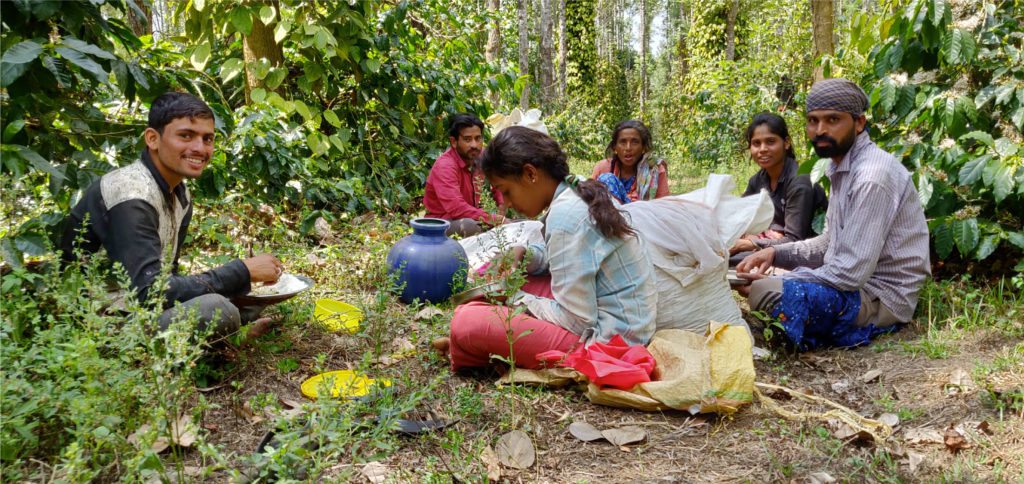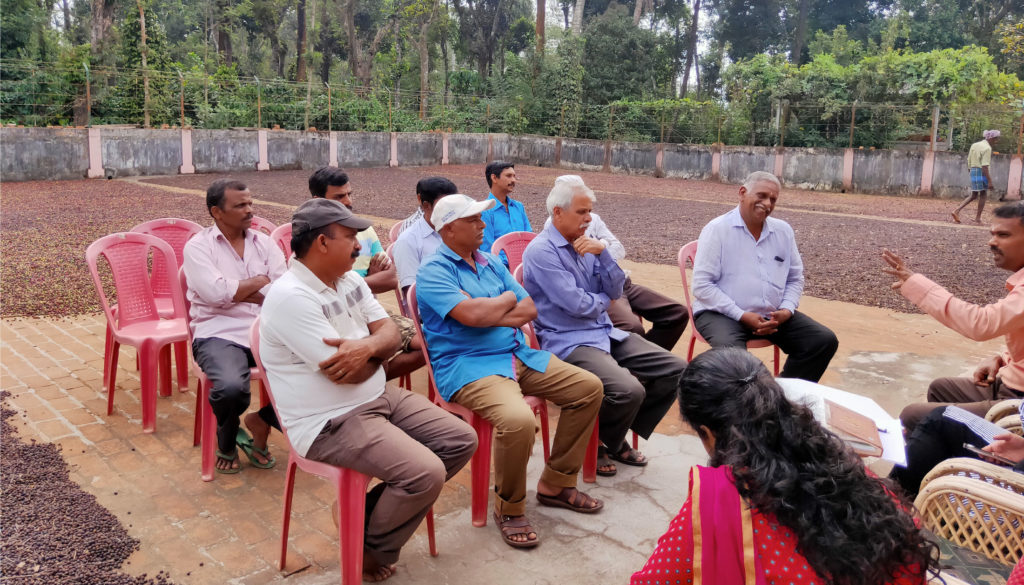Brewing better weather services for Indian coffee farmers
- May 17, 2022
- 7 minutes read
Accurate, medium-range weather forecasting information can help mitigate smallholder farmers’ exposure to climate-related risks. PxD is in the process of launching new products to assist smallholder farmers to make more informed and timely decisions based on weather information. In this post, we outline the contours of our exploratory research to integrate weather forecasts into Coffee Krishi Taranga (CKT), our existing digital advisory service for small coffee farmers in India.

Coffee is a notoriously fickle crop. For example, heavy rainfall can damage crops, result in premature fruit-drop, increase the incidence of pests, and wash away fertilizer with negative implications for plant nutrient levels. Increasing weather variability and the incidence of extreme weather events associated with climate change will have significant negative effects on coffee producers. Given the sensitivity of the crop — and yields — to fluctuations in the weather, coffee farmers are likely to derive meaningful benefits from accurate and timely weather forecasts. Insights from our CKT learning agenda will be used to inform the design of a larger evaluation of the weather-integrated service and to scale an enhanced service to over 150,000 coffee farmers across four Indian states (Karnataka, Kerala, Tamil Nadu, and Andhra Pradesh – an expansion state).
The motivation
PxD delivers CKT in partnership with the Coffee Board of India and with support from the Walmart Foundation. Since 2018, CKT has delivered a two-way interactive voice response (IVR) service with two principal components: an outgoing push call service that provides regular advisory to coffee growers via their mobile phones, and an inbound hotline that farmers can call to access free information services. In April 2022, CKT reached just over 70,000 smallholder coffee farmers in Karnataka, Kerala, and Tamil Nadu.
More accurate information about medium-term rainfall — with a lead time of up to 15 days — will enable farmers to make informed decisions about applying nitrogen fertilizer and increase the likelihood that they apply this input during dry spells to reduce run-off and leaching. Similarly, if farmers are alerted to impending heavy rain, they can leverage this information to alter harvesting times or take other precautionary measures to protect crops and insulate yields.
Speaking to farmers to inform design and process
In interviews conducted with coffee growers in August 20211 Described further in an earlier blog post that outlined findings from the landscape analysis of coffee production in Karnataka and Andhra Pradesh relating to sustainability, market linkages, and gender., only 16% of respondents reported accessing forecasts (N=73). Integrating weather information into CKT’s existing services will broadcast weather forecasts to farmers tailored to their specific contexts and complement these forecasts with agronomist-designed advice. Exploratory and pilot research will be implemented between May and December 2022 in three important coffee-growing districts in Karnataka: Chikmagalur, Hassan, and Kodagu.
Studies conducted in other contexts find that farmers form subjective expectations about upcoming weather events based on various factors, including their past experiences, local rules of thumb, existing forecast information, the costs and benefits of acquiring such information, and perceptions about how relevant weather-related risk is to their incomes2As demonstrated in Giné, X., Townsend, R.M., & Vickery, J. (2015). “Forecasting When it Matters: Evidence from Semi-Arid India.” Working Paper.. These expectations inform behavior over the course of the coffee crop cycle as farmers make decisions relating to input and investment choices, the timing of activities, and so on. The sum of these decisions, in turn, influences outcomes that farmers (as well as researchers and practitioners) are interested in – notably plant health, yields, costs, and profits. The goal of this research is to understand each of these elements through measurement and service pilots, A/B tests, qualitative interviews, and in-person workshops with farmers, agronomists, and extension agents.

Coffee laborers having lunch on a coffee farm.
Iterating relevant service design and a weather service at scale
Commencing in May 2022, we will conduct multiple rounds of in-depth qualitative interviews with men and women coffee farmers. The sample will include farmers working a range of landholding sizes and will include both smartphone and feature-phone owners. The objective of the first set of interviews is to better understand how coffee farmers make decisions relating to the timing of agronomist-identified, weather-dependent coffee activities: fertilizer and lime application, coffee pruning, shade regulation, and harvesting. We hope to identify how weather fits into these decisions and what other factors influence the timing of these activities. If other limiting factors (such as the availability of an input) impact timing to a greater extent than the weather, forecast information with short lead times may not help farmers optimally time their practices without access to complementary inputs or information. These interviews will also help us identify how farmers interpret weather forecasts they already have access to, what impact incorrect forecasts have on their activities and on their trust in forecasts and the extent to which farmers discuss their expectations of upcoming weather with other members of their communities.
As detailed in previous blog posts about our weather-related work, PxD is partnering with leading private forecast provider CFAN (Climate Forecast Applications Network) to develop calibrated custom forecasts. Using weather forecasts from CFAN provides access to a continuous stream of information, which includes the numerical quantity of a rainfall event being forecast, numerical probabilities associated with a forecasted weather event, and error margins on the quantity of rainfall forecast for each of the upcoming 15 days3Read more about our collaboration in this previous blog post. Building on the first set of qualitative interviews, we plan to assess (1) whether farmers comprehend and have an appetite for probabilistic and uncertain information; (2) whether specific forecast attributes or lead times meaningfully change farmers’ expectations of upcoming weather; and (3) which combinations of attributes and lead times aid decision-making for each weather-dependent activity. We plan to gauge farmers’ understanding of probabilities and uncertainty in a second set of in-person interviews to whittle down the forecast formats that will be most useful in this context.

PxD facilitated Interviews with coffee growers.
Coffee farmers in a subset of villages in our three study districts will then be invited to participate in in-person workshops, where they will interact with different forecasting formats. The workshop will be in the form of a ‘lab-in-the-field experiment’, where participants engage with an interactive platform that presents weather forecasts together with incentivized agricultural decision-making scenarios. Utilizing participants’ decisions on the platform, an ‘in-scenario’ weather ‘realization’ will be simulated, allowing participants to accrue a higher payoff for a ‘better’ decision. The best-performing forecast will accrue the highest cumulative payoff across participants and will inform our understanding of which forecast formats most effectively aid decision-making. The ‘best-performing’ customized-to-context weather forecast will then be piloted in the field among a sample of existing CKT users to evaluate whether it improves decision-making in a real-world setting.
Delivering an effective weather-based advisory service via mobile phone also requires that we ensure that users engage with and use the information being delivered. To this end, we plan to run A/B tests to optimize the frequency with which weather forecasts are delivered, the length of messages, and other service features.
We are optimistic about the utility of weather forecasting information and its potential impact on smallholder farmers — and their productivity — as they make what we hope will be more informed decisions. We are excited to deploy this information and make it actionable for smallholder coffee producers on our CKT service. Watch this space!


Stay Updated with Our Newsletter

Make an Impact Today


